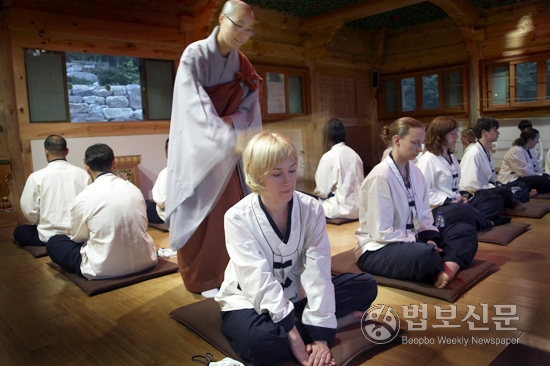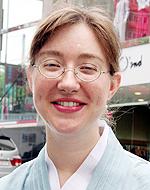명상을 불교적인 수련법으로 여기지만
서구에는 명상에만 몰두하는 사람 많아
불자는 아니지만 명상에 몰입하다 보면
염불진언 등 전통수행법에도 진력할 것
|
미국과 캐나다, 유럽 등지에서 활동하고 있는 불교 법사 200여명이 함께 한 불교법사회의에서는 참으로 다양하고도 충격적인 의견들이 개진되었다. 그러한 토론에서는 나를 변화시킬만한, 내가 주목할 만한 매우 이채로운 주장이나 아이디어들이 있었다. 부처님의 가르침을 어떻게 보존하고 있고 또 수행하고 있으며 어떻게 전승할 것인가 등에 대한 서구 법사들의 실질적인 방법이나 고민들을 엿볼 수 있었다. 회의에서 제기된 흥미로운 주제 중 하나가 바로 ‘명상수행을 하지 않는 불자’와 ‘불자가 아닌 명상 수련가’이다. 이러한 주제는 명상 수련자는 거의 모두가 ‘불자’라는 고정 관념을 깨뜨리는 것이리라.
충격적인 순간 1.
“사실 저는 부처님의 가르침에 대해서 아는 것이 전혀 없습니다.”
불교법사회의에 참여한 한 법사가 소규모 토론에서 나에게 수련법에 대해 말했다. 그 법사가 말한 수련법은 30년 전 ‘존 카밧진’ (Jon Kabat-Zinn) 박사가 개발해 널리 보급되어 영향력이 증대된 ‘마음챙김 수련에 근거한 스트레스 감소 (Mindfulness Based Stress Reduction:MBSR)’ 프로그램에서 지도하고 있는 ‘마음챙김’ 명상이다.
충격적인 순간 2.
정토진종(淨土眞宗)을 대표해서 미국불교단(Buddhist Churches of America) 소속의 한 일본인 스님의 말 역시 나에게 충격적으로 다가왔다. 그는 힘주어 말했다.
“수미 법사, 지난 밤 법사 중 한 사람이 나에게 오늘 아침 자신들의 그룹을 위해 명상 수행을 지도해달라고 요청해 왔어. 나는 명상을 수행하거나 가르치지 않는다는 점을 말하고자 노력했어. 단지 진종(眞宗)이라고, 그러나 그는 내가 하는 말을 이해하지 못했어.”
스님의 말에 나는 “아마도 그는 진(眞)을 선(禪)으로 잘못 들었을 수도 있어요”라며 나름의 의견을 제시했다. 그러면서 “걱정하지 마세요. 제가 명상 수행을 지도할 분을 찾아 볼께요”라고 말한 뒤 수행자로서의 위의가 느껴지는 법복을 수한 채 좌선에 진력하고 있는 선승에게 다가갔다.
불교법사들의 모임을 통해 서구의 불자들은 의도하지는 않았지만 수행에 관한 기본적인 개념 정의와 관련된 이슈와 마주하게 되었다. 먼저 종합병원과 전문병원, 학교, 체육관, 치료 시설, 기타의 기관에서 ‘마음챙김’ 명상수련을 지도하고 있는 수백, 수천의 교사들이 현재 활동하고 있다. 이들 교사들은 위의 예시 1의 경우와 같이 그들의 수련체계가 불교에 근거하고 있다고 믿고 있기는 하지만 명상 그 자체 이외의 불교 전반에 대해서는 잘 알지 못하고 있었다. 그렇다고 해서 이런 사실 자체가 그들의 중요성을 감소시키는 것은 아니다. 왜냐하면 ‘마음챙김 수련에 근거한 스트레스 감소(MBSR)’ 수련법은 전 세계에서 수백만 명의 심리적인, 영적인 웰빙(well-being)에 중요한 역할을 했다는 사실은 너무도 명백하기 때문이다. 만약 그것이 명시적으로 ‘불교적 방식’이라고 표방했다면 아마도 그 사람들은 그런 수련을 시도조차 하지 않았을지도 모를 일이다. 참으로 그런 프로그램을 창시한 지도자들 중 일부는 불법(佛法) 자체에 대한 매우 헌신적인 구도자였으며 또한 법사 회의에서도 “그렇다”라고 말했다. 하지만 명상 수행자이자 일반적인 의미에서의 불자인 내가 현실에서 부딪치는 것은 ‘마음챙김 뿐인 법사들’을 제한해 토론하고 있다는 사실이다. 예를 들면 오계(五戒)를 재가 불자에게 어떻게 효과적이고 현대적인 방법으로 가르칠 것인가에 대해 파고들 수가 없었다. 이유는 간단하다. 그들은 오계 자체에 대해 전혀 모르고 있기 때문이다. 어떻게 그렇게 많은 ‘마음챙김’ 명상 법사들이 회의에 참여했는지 놀랍기만 했다. 그럼에도 그들 대부분은 서구인이었고 명상 수행이 대다수 서구 불자들의 핵심 수행법이었기 때문에 여러 측면에서 그들은 이번 회의의 기본적인 목적에 잘 어울리는 것 같았다.
둘째로, 일련종(日蓮宗)과 정토진종(淨土眞宗) 같은 비(非) 명상수행 전통계열의 종파 출신 법사들도 똑같이 어떠한 가정(假定)을 전제했다. 법사들 간 대화의 약 75%가 명상수행과 교육, 일상생활, 재능, 학생 등과의 관계에 대해 참조하거나 그것을 중심으로 전개되었다. 명상이 그 회의 전체의 틀을 형성했다. 매일 아침 명상이 진행되었고 때때로 토론을 시작하기 전에도 명상을 했다. 비(非) 명상수행 전통계열 종파의 법사들과는 불교나 불교문화에 대해 매우 쉽게 대화를 나눌 수 있었다. 예를 들어 ‘나무아미타불’ 염불과 헌신을 위한 장소에 대해 그들과 연결시킬 수가 없었다. 이러한 형식의 수행을 하는 서구 불자는 거의 없었기 때문이다. 이런 유형의 불교적 수행이나 전통은 대다수 서구 불교 법사들의 경험과는 아주 다른 것이었다. 기실 비(非) 명상수행 전통계열의 수행을 따르는 불교 법사들이 법사회의에 동참하게 된 것은 내가 초청했기 때문이다. 이번 법사회의 조직위원회의 구성원들은 이런 유형의 불교전통에 대해 익숙하지 않았다. 그러나 나의 경우는 상당히 달랐다. 나의 학문적인 배경 때문에, 한국 수행자와의 결혼을 통해 나는 이런 유형의 불교전통에 보다 폭넓게 친분을 쌓게 되었다.
법사회의는 그 속성상 현재 서구 불자들의 수행 형태나 지형을 파악할 수 있게 해주었다. 불교 명상법을 보다 세속적인 형태로 수행하는 사람들이 있었다. 불자이지만 명상 수행을 하지 않는 경우도 많았다. 특히 아시아계 미국인들이 그러했다. 그리고 그 중간에 명상 수행을 하는 상당수의 불자들이 있었다. 이러한 양 극단의 형태가 앞으로 어떻게 발전하고 변화할지에 대해 지켜보는 것은 매우 흥미로운 일임에 분명하다. 향후 10년 사이에 명상 수련을 하는 사람들이 명상을 심리 이해에만 적용하는 것은 편협하다는 견해를 자각하고 보다 깊은 영적인 추구를 하게 될까? 아니면 견해가 다른 극단에 있는 쪽에서는 명상에 대해 벌어지고 있는 소동이 무엇인지 궁금해 하고 명상이 가르침의 깊이를 더해준다는 사실을 발견하게 될까?
나는 명상을 불교 홍포를 위한 ‘조미료’라고 규정하는 것을 긍정적으로 생각한다. 명상은 모든 것에 더 깊은 맛을 가미해준다. 내 생각에는 그렇지 않다고 생각하지만 아무튼 양 극단은 그 스스로가 온전히 충분하다고 생각하면서 스스로 설정한 기준에 따라 계속 그렇게 전개될 것이다.
|
어떻게 변화하든 간에 지금으로부터 10년 후 법사 회의에서도 똑 같은 질문에 부딪치게 될 게 분명하다.
과연 불교 회의는 누구를 위한 것인가?
수미런던 듀크 불교공동체 지도법사 simplysumi@gmail.com
번역 백영일 위원 yipaik@wooribank.com
다음은 영어원고 전문.
Buddhists Who Don’t Meditate
and Meditators Who Aren’t Buddhist
In June, I attended a conference of about 200 Buddhist teachers who teach in the United States, Canada, and Europe. The experience of that week was so rich and transformative for me that I have been writing about it in previous columns and may continue for a few more. You’ll get a good idea of what kinds of discussions teachers in the West are having about how to preserve, practice, and transmit the Buddha’s teachings. This week’s column focuses on the divide between Buddhists who don’t meditate and meditators who aren’t Buddhist.
Striking Moment #1: “Actually, I don’t know anything about the Buddha’s teachings,” said one of the teachers at the conference for Buddhist teachers to me during a small group discussion. This teacher’s training was in mindfulness meditation, as taught by the widespread and influential Mindfulness Based Stress Reduction (MBSR) program developed by Dr. Jon Kabat Zinn thirty years ago.
Striking Moment #2: A Japanese priest from the Buddhist Churches of America, the Jodoshin school representative, came up to me in a panic. He said with a strong accent, “Sumi, last night one of the teachers asked me to lead meditation for the group this morning. I tried to tell him I don’t do or teach meditation, only Shin Buddhism, but he didn’t understand what I said.” “I think he may have misheard ‘Shin’ as ‘Zen,’” I said. “Don’t worry, I will find someone to lead the meditation,” and went over to a Zen sensei (teacher) sitting in an elegant array of vestments.
This gathering of Buddhist teachers revealed some interesting definitional issues that we in the West are bumping up against. First, there are now hundreds, maybe even thousands, of people teaching mindfulness meditation in hospitals, clinics, schools, gyms, therapeutic settings, and elsewhere. These teachers, as was the case in example #1, very often know that their system is Buddhist-inspired but are unfamiliar with much else from Buddhism but the meditation itself. This is in no way to diminish the significance of their work, because it is quite clear to me that MBSR has made a major contribution to the psychological and spiritual well-being of thousands and thousands of people ? people who might never have tried it if it were explicitly Buddhist ? worldwide. Indeed, some of the founders of the program are deeply committed students of the Buddhadharma themselves, and said so at the conference. But I found, as a teacher who is both a meditator and a Buddhist in the common sense of it, that I could only discuss so much with mindfulness-only teachers. You could not, for example, dig into how to teach the five precepts for lay people in an effective, contemporary way, because they did not know the five precepts themselves. I had to wonder how it was that so many mindfulness meditation teachers ended up at the conference. Yet, because many of them are Westerners, and because meditation is the core practice of most Western Buddhists, in many regards they fit well with the ethos of the conference.
Second, the Buddhist teachers from the non-meditation lineages such as Nichiren school and Jodoshin school likewise brought out an assumption. Probably 75% of the conversations among the teachers referenced or revolved around the connection between meditation practice and teaching, daily life, facilities, students, and so on. Meditation framed the entire conference: there was daily morning meditation, sometimes we did meditation before a discussion session, etc. I found that with the non-meditating lineage teachers, I could talk about Buddhism and Buddhist culture quite easily, but I was unable to connect with them about the place of, for example, chanting or devotion to Amitabha Buddha because few Western Buddhists practice this. These forms of Buddhism fall fairly far outside the Buddhist experience of many Western Buddhist teachers. In fact, the non-meditating Buddhist teachers who came were there by my invitation: the organizers did not have much of a connection to these lineages. My connection was only because of my academic background and because I am more aware of these lineages through my marriage (to a Korean Buddhist).
This conference essentially provided a current map of the Western Buddhist landscape. We have many who practice a rather secular form of Buddhist meditation. We have many, particularly Asian Americans, who are Buddhist but don’t meditate. And then in the middle, there are a good number of Buddhists who meditate. It will be interesting to see how these two ends of the spectrum develop: over the next decade, will those who meditate begin to find the application of meditation as psychology limited and search for spiritual depth? Will the other end of the spectrum become curious as to what all the fuss about meditation is and find that it provides depth to the teachings? (I like to think of meditation as the MSG [monosodium glutamate] of Buddhism: it gives everything a richer flavor.) Or maybe each end will find the thing itself wholly sufficient (obviously, I don’t think each is) and continue to work within the parameters each style has set out for itself. Whatever happens or not, a conference ten years from now will face the same question: who is a Buddhist conference for?



